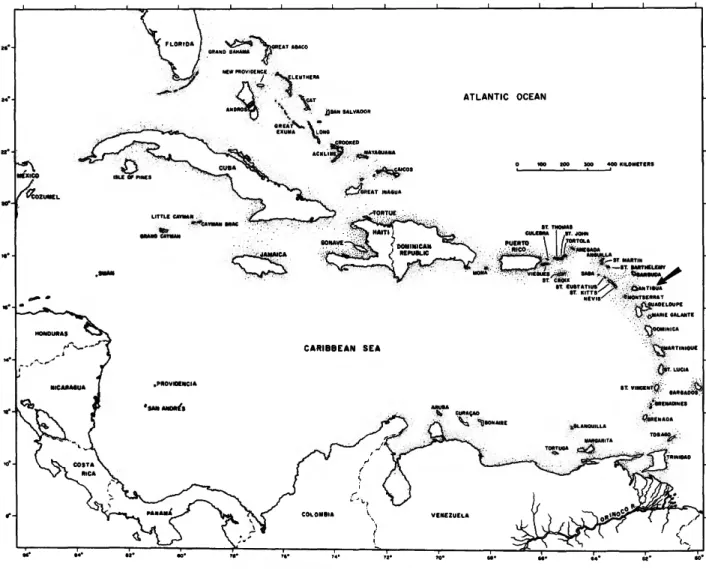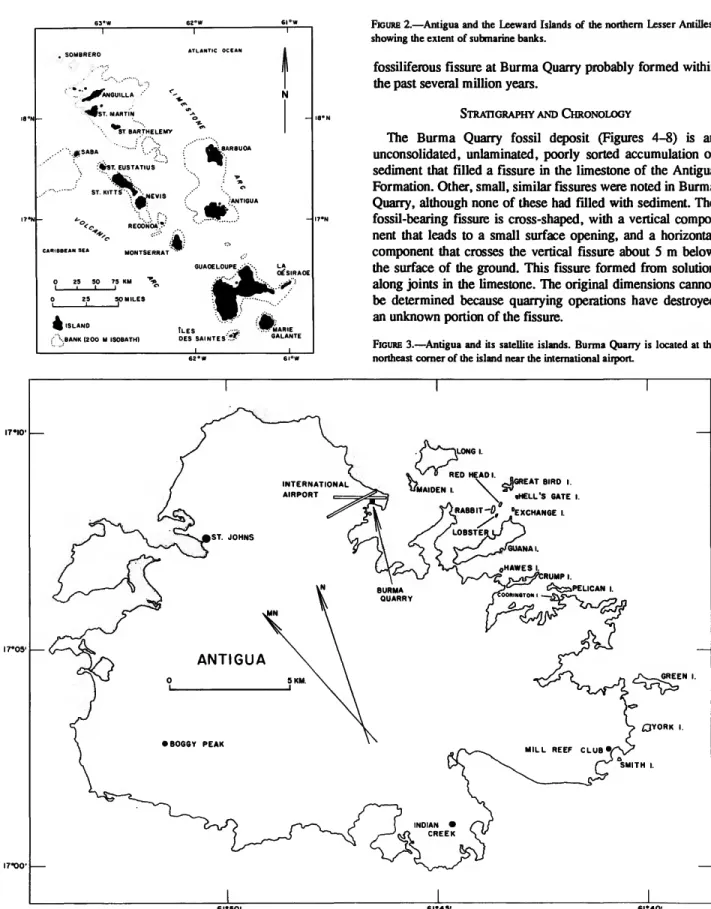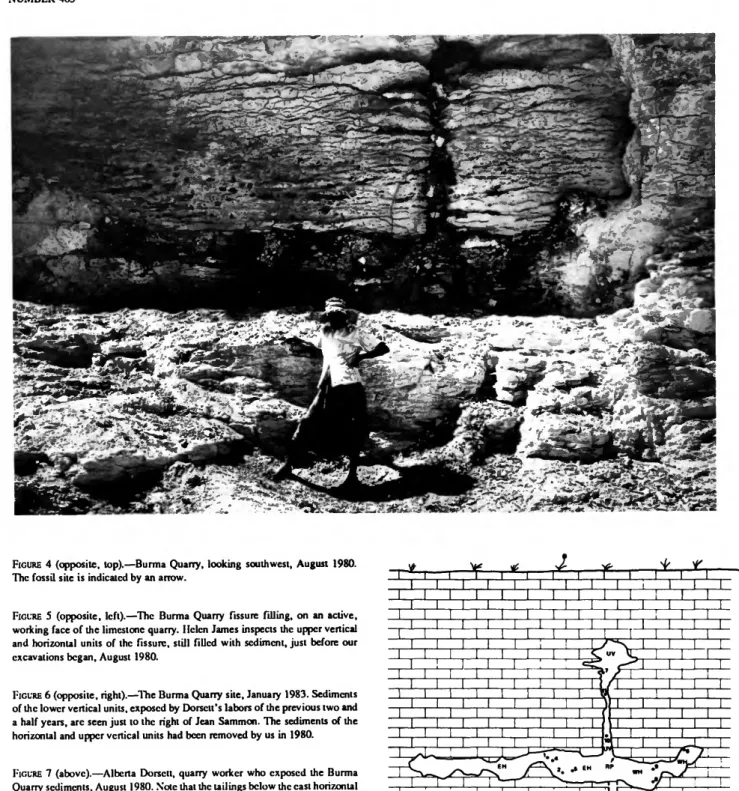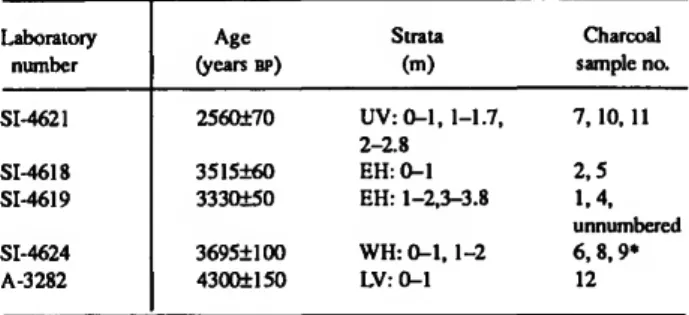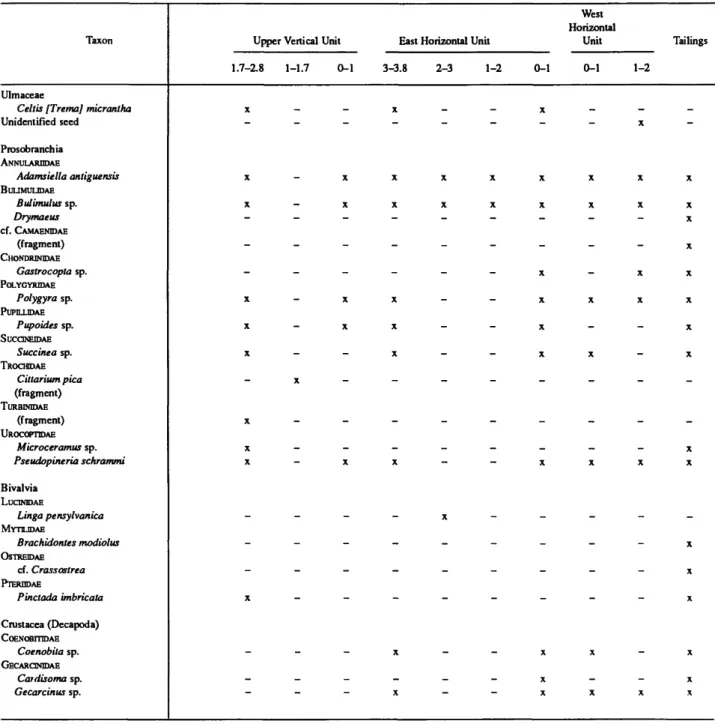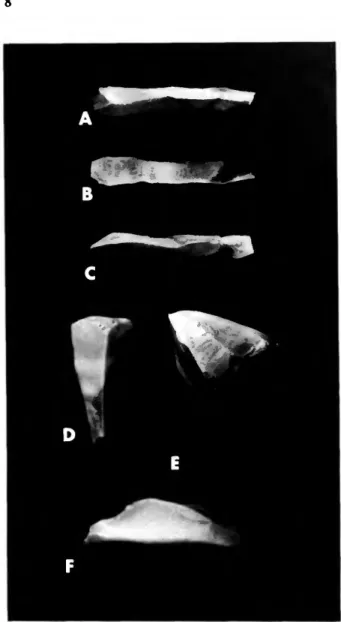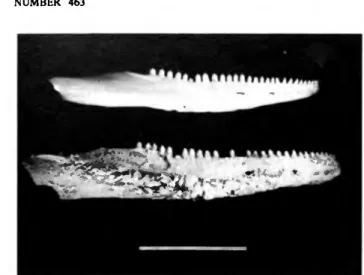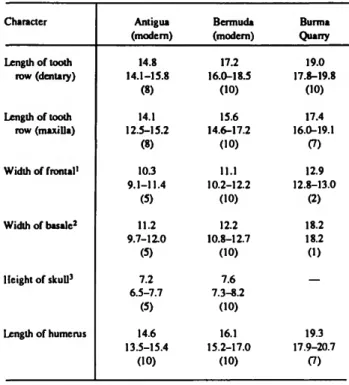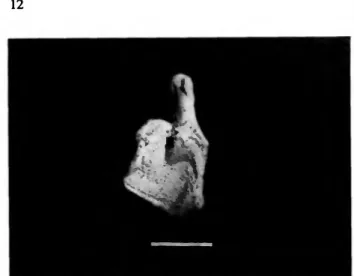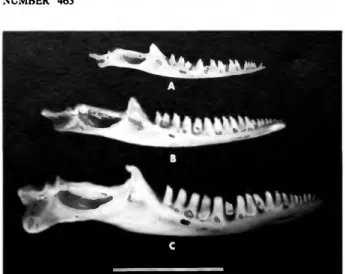Late Holocene Fossil Vertebrates from Burma Quarry, Antigua,
Lesser Antilles
GREGORY K. PREGILL, DAVID W. STEADMAN, STORRS L. OLSON and FREDERICK V. GRADY
SMITHSONIAN CONTRIBUTIONS TO ZOOLOGY • NUMBER 463
SERIES PUBLICATIONS OF THE SMITHSONIAN INSTITUTION
Emphasis upon publication as a means of "diffusing knowledge" was expressed by the first Secretary of the Smithsonian. In his formal plan for the Institution, Joseph Henry outlined a program that included the following statement: "It is proposed to publish a series of reports, giving an account of the new discoveries in science, and of the changes made from year to year in all branches of knowledge." This theme of basic research has been adhered to through the years by thousands of titles issued in series publications under the Smithsonian imprint, commencing with Smithsonian Contributions to Knowledge in 1848 and continuing with the following active series:
Smithsonian Contributions to Anthropology Smithsonian Contributions to Astrophysics
Smithsonian Contributions to Botany Smithsonian Contributions to the Earth Sciences Smithsonian Contributions to the Marine Sciences
Smithsonian Contributions to Paleobiology Smithsonian Contributions to Zoology
Smithsonian Folklife Studies Smithsonian Studies in Air and Space Smithsonian Studies in History and Technology
In these series, the Institution publishes small papers and full-scale monographs that report the research and collections of its various museums and bureaux or of professional colleagues in the world of science and scholarship. The publications are distributed by mailing lists to libraries, universities, and similar institutions throughout the world.
Papers or monographs submitted for series publication are received by the Smithsonian Institution Press, subject to its own review for format and style, only through departments of the various Smithsonian museums or bureaux, where the manuscripts are given substantive review.
Press requirements for manuscript and art preparation are outlined on the inside back cover.
Robert McC. Adams Secretary
Smithsonian Institution
Late Holocene Fossil Vertebrates from Burma Quarry,
Antigua, Lesser Antilles
Gregory K. Pregill, David W. Steadman, Storrs L. Olson, and Frederick V. Grady
SMITHSONIAN INSTITUTION PRESS Washington, D.C.
1988
ABSTRACT
Pregill, Gregory K., David W. Steadman, Storrs L. Olson, and Frederick V. Grady. Late Holocene Fossil Vertebrates from Burma Quarry, Antigua, Lesser Antilles. Smithsonian Contributions to Zoology, number 463, 27 pages, 17 figures, 9 tables, 1988.—Vertebrate fossils collected from a limestone fissure filling at Burma Quarry on Antigua, Lesser Antilles, are associated with radiocarbon dates ranging from 4300±150 to 2560±70 years BP, contemporane- ous with the earliest aboriginal human occupation of the island. Four Amerindian lithic artifacts (two blades and two flakes) were collected within the same sediments. Two taxa of invertebrates and ten of vertebrates from Burma Quarry are either completely extinct or have not been recorded previously from Antigua. These species, which represent more than one-third of the total number of species represented as fossils, include the land crabs Cardisoma and Gecarcinus, the lizard Leiocephalus cuneus, the snakes Alsophis antillensis and an uncertain genus, possibly Boidae, the birds Puffinus Iherminieri, Poliolimnas flaviventer, and Cinclocerthia ruficauda, the bats Pteronotus parnellii, Mormoops blainvillei, and Phyllonycteris major, and a rodent (Oryzomyini sp.). The extinction of these vertebrates occurred well after any major climatic changes of the late Pleistocene and are best attributed to the environmental influences of man over the past several millennia. Such biotic alterations have affected patterns of distribution and species diversity throughout the West Indies and other island groups. The faunal distinctions between the Greater and Lesser Antilles have been exaggerated by late Holocene extinctions in the northern Lesser Antilles. Ecological and biogeographical studies in the West Indies that consider only the historically known fauna are likely to be based upon data that do not completely reflect natural events.
OFFICIAL PUBLICATION DATA is handstamped in a limited number of initial copies and is recorded in the Institution's annual report, Smithsonian Year. SERIES COVER DESIGN: The coral Montastrea cavernosa (Linnaeus).
Library of Congress Cataloging-in-Publication Data
Late Holocene fossil vertebrates from Burma Quarry, Antigua, Lesser Antilles.
(Smithsonian contributions to zoology ; no. 463) Bibliography: p.
Supt of Docs, no.: SI 1.27:463
1. Vertebrates, Fossil. 2. Paleontology—Recent 3. Paleontology—Antigua and Barbuda. I. Pregill, Gregory K. II. Series.
QL1.S54 no. 463 591s 87-600263 [QE841] [566'.097297'4]
Page
Introduction 1 Acknowledgments 1 Site Description 2 Geographical and Geological Setting 2 Stratigraphy and Chronology 3 Cultural Materials 6 Nonvertebrate Remains 8 Plantae 8 Mollusca 8 Crustacea 9 Systematic Accounts 9 Amphibians and Reptiles 9 Order ANURA 9 Family LEPTODACTYLIDAE 9 Eleutherodactylus johnstonei Barbour 9 Order SQUAMATA 10 Family GEKKONIDAE 10 Thecadactylus rapicauda Houttuyn 10 Family IGUANIDAE 10 Anolis bimaculatus leachi Dumdril and Bibron and Anolis spp 10 Leiocephalus cuneus Etheridge 11 Family TEIIDAE 12 Ameiva griswoldi Barbour 12 Family COLUBRIDAE 13 Alsophis cf. A. antillensis Schlegel 13 Family TYPHLOPIDAE 14 Typhlops monastus Thomas 14 Family cf. BOIDAE 14 Genus and Species Indeterminate 14 Birds 15 Order PROCELLARIIFORMES 15 Family PROCELLARIIDAE 15 Puffinus Iherminieri Lesson 15 Order RALLIFORMES 15 Family RALLIDAE 15 Poliolimnas flaviventer (Boddaert) 15 Order CHARADRIIFORMES 16 Family SCOLOPACIDAE 16 Calidris species 16 Order COLUMBIFORMES 16 Family COLUMBIDAE 16 Zenaida aurita (Temminck) 16 Columbine passerina Linnaeus 16 Order STRIGIFORMES 17 Family STRIGIDAE 17 Athene cunicularia (Molina) 17
iii
SMITHSONIAN CONTRIBUTIONS TO ZOOLOGY
Order TROCHOFORMES 17 Family TROCHUJDAE 17 Orthorhynchus cristatus (Linnaeus) 17 Order PASSERIFORMES 17 Family TYRANNIDAE 17 Tyrannus cf. T. dominicensis (Gmelin) 17 Family MIMTOAE 17 Margarops fuscatus (Vieillot) 17 Cinclocerthia ruficauda (Gould) 18 Family FRINGILLIDAE 19 Loxigilla noctis (Linnaeus) 19 Order PASSERIFORMES, Species Indeterminate 19 Indeterminate Bird 19 Mammals 19 Order CMROPTERA 19 Family MORMOOHDAE 19 Pteronotus parnellii (Gray) 19 Mormoops blainvillei Leach 20 Family PHYLLOSTOMATIDAE 20
?Monophyllus species 20 Brachyphylla cavernarwn Gray 20 Phyllonycteris cf. P. major Anthony 20 Family NATALIDAE 21 Natalus stramineus Gray 21 Family TADARIDAE 22 Tadarida brasiliensis (I. Geoffroy) 22 Family MOLOSSIDAE 22 Molossus molossus (Pallas) 22 Order CHIROPTERA, Species Indeterminate 22 Order RODENTIA 22 Family MURIDAE 22 Subfamily CRICETINAE 22 Tribe ORYZOMYINI species 22 Discussion 22 Literature Cited 25
Late Holocene Fossil Vertebrates from Burma Quarry, Antigua,
Lesser Antilles
Gregory K. Pregill, David W. Steadman, Storrs L. Olson, and Frederick V. Grady
Introduction
Human impact on insular environments is a topic that has become increasingly relevant to theoretical and empirical studies of islands. For many islands, the fossil record demonstrates the synchrony of human colonization and the extinction of vertebrates, as in Madagascar (Tattersall, 1982), New Zealand (Cassels, 1984), Hawaii (Olson and James, 1982a,b), and Galapagos (Steadman, 1986). Essentially all islands have been altered to some extent by man, regardless of their size, accessibility, or biotic complexity.
We found new evidence of man's impact in the Lesser Antilles in fossiliferous sediments that filled a limestone fissure at Burma Quarry, Antigua, that we excavated in 1980 and 1983. The fossils reviewed here document the late Holocene occurrence of many species of vertebrates that no longer occur on the island. The salient results and implications of our studies have been summarized elsewhere (Steadman, Pregill, and Olson, 1984). Herein we document our findings in much greater detail.
ACKNOWLEDGMENTS.—We thank Ronald I. Crombie, James P. Dean, and Helen F. James of the Smithsonian Institution, Desmond Nicholson of the Leeward Island Science Associa- tion, Antigua, Alberta Dorset of Antigua and Jean A. Sammon for assistance in the field. This research was supported by funds generously donated to the Division of Birds, Smithsonian Institution, by Mrs. Alexander Wetmore, by the Smithsonian's Scholarly Studies Program, and by the National Science
Gregory K. Pregill, Department of Herpetology, San Diego Natural History Museum, P.O. Box 1390, San Diego. California 92112. David W. Steadman, Biological Survey, New York State Museum, Albany, New York 12230. Storrs L.
Olson, Department of Vertebrate Zoology, National Museum of Natural History, Smithsonian Institution, Washington, D.C. 20560. Frederick V. Grady, Department of Paleobiology, National Museum of Natural History, Smithsonian Institution, Washington,DC. 20560.
Review Chairman: Stanley H. Weitzman.
Foundation (Grant DEB-8207347 to GKP). We appreciate the cooperation and assistance of officials of the government of Antigua and of the Antigua-based U.S. Satellite Tracking Station. Derrick Michael, Permanent Secretary, Ministry of Agriculture, and Archie King, Permanent Secretary, Ministry of Education and Culture, facilitated permits. Major Jerry Beirenger, Commander of the US AF base, and Larry DeFreitas facilitated shipment of concentrate. Paul Byrnes, then Ameri- can Consul General, and his office were very helpful. Mr. and Mrs. C. T. Bufton provided kind hospitality during our visits to Guana Island. For radiocarbon ages, we thank Robert Stuckenrath (Smithsonian Institution), Austin Long and Timothy Linick (University of Arizona). For the loan of specimens, we thank Pere Alberch and Jose Rosado (Museum of Comparative Zoology, Harvard University), Peter Meylan (Florida State Museum), and Ronald I. Crombie and W. Ronald Heyer (National Museum of Natural History, Smithsonian Institution). We are grateful for specimen identifications provided by the Smithsonian Institution staff: Richard H. Eyde (plants), William W. Fitzhugh (artifacts), Linda K. Gordon and Gary S. Morgan (certain bats), Karl F. Koopman {Phyllo- nycteris major), Raymond B. Manning (crustaceans), and the late Joseph Rosewater (mollusks). Ellen M. Paige drew Figures 1 and 2, the latter based on an original kindly supplied by David R. Watters. Photographs of maps and specimens of birds, bats, and artifacts are by Victor E. Krantz, who also printed the photographs taken by us in the field. We are grateful to Ronald I. Crombie and David R. Watters for helpful comments on portions of the manuscript. Watters' detailed comments on the archeological context of the site are particularly appreciated. This is contribution number 505 of the New York State Science Service.
SMITHSONIAN CONTRIBUTIONS TO ZOOLOGY
Site Description
GEOGRAPHICAL AND GEOLOGICAL SETTING
Antigua is in the northern part of the Lesser Antilles, within the Leeward Island group, on the same bank as Barbuda (Figures 1, 2). Together, these two islands formed one much larger island during lowered sea levels of Quaternary glacial intervals. Whereas the bedrock of Barbuda is exclusively carbonate, that of Antigua consists of three distinctive types, which in turn represent three physiographic provinces known as the limestone district, the central plain, and the volcanic district (Harris, 1965, fig. 3). The volcanic district of southern Antigua consists of weathered late Tertiary volcanics that produce a hilly to mountainous terrain that rises to a height of 423 m at Boggy Peak. Five other peaks exceed 300 m in
elevation. In between the volcanic and limestone districts is the central plain, an area of late Tertiary sedimentary rocks derived from erosion of the volcanics to the south. These sedimentary rocks are secondarily eroded into a terrain of rolling hills with shallow valleys.
Northern and eastern Antigua consists of limestone that makes up part of the Antigua Formation, which by invertebrate fossils is late middle Oligocene to late Oligocene (Frost and Weiss, 1979), ca. 30 to 23 m.y.a.
The Burma Quarry fossil site developed in the carbonates of the Antigua Formation and is located in St. George Parish of north-central Antigua, between the Antigua International Airport and a shallow embayment known as Winthorpes Foot Creek (Figure 3). The elevation of the site is about 10 m above sea level. Burma Quarry itself (Figure 4) is an active limestone quarry that produces crushed stone for construction. The
ATLANTIC OCEAN
FIGURE 1.—Map of the West Indies showing location of Antigua (arrow).
. MARTIN
^ T BARTHELEMV
i%-ST. EUSTATIUS
MONTSERRAT
0 25 50 75 KM "
50 MILES 0 25
' tLES
•BANK (200 M ISOBATH) DES SAINTES lELOUPE^k-..
.... - ^ ^ DESIRADE
FIGURE 2.—Antigua and the Leeward Islands of the northern Lesser Antilles, showing the extent of submarine banks.
fossiliferous fissure at Burma Quarry probably formed within the past several million years.
STRATIGRAPHY AND CHRONOLOGY
The Burma Quarry fossil deposit (Figures 4-8) is an unconsolidated, unlaminated, poorly sorted accumulation of sediment that filled a fissure in the limestone of the Antigua Formation. Other, small, similar fissures were noted in Burma Quarry, although none of these had filled with sediment. The fossil-bearing fissure is cross-shaped, with a vertical compo- nent that leads to a small surface opening, and a horizontal component that crosses the vertical fissure about 5 m below the surface of the ground. This fissure formed from solution along joints in the limestone. The original dimensions cannot be determined because quarrying operations have destroyed an unknown portion of the fissure.
FIGURE 3.—Antigua and its satellite islands. Burma Quarry is located at the northeast corner of the island near the international airport.
. f^-* ILONG I.
^ i > RE
GREAT BIRD I.
SMITHSONIAN CONTRIBUTIONS TO ZOOLOGY
FIGURE 4 (opposite, top).—Burma Quarry, looking southwest, August 1980.
The fossil site is indicated by an arrow.
FIGURE 5 (opposite, left).—The Burma Quarry fissure filling, on an active, working face of the limestone quarry. Helen James inspects the upper vertical and horizontal units of the fissure, still filled with sediment, just before our excavations began, August 1980.
FIGURE 6 (opposite, right).—The Burma Quarry site, January 1983. Sediments of the lower vertical units, exposed by Dorsett's labors of the previous two and a half years, are seen just to the right of Jean Sammon. The sediments of the horizontal and upper vertical units had been removed by us in 1980.
FIGURE 7 (above).—Alberta Dorsctt, quarry worker who exposed the Burma Quarry sediments, August 1980. Note that the tailings below the cast horizontal unit, evident in Figure 5, have been removed.
FIGURE 8 (right).—Stratigraphic profile of the Burma Quarry fissure fill. UV
= upper vertical units; LV = lower vertical units; FH = cast horizontal units;
W I U west horizontal units; RP = reference point from which all measurements were made. The numbered dots indicate the radiocarbon samples listed in Table 1. The area enclosed by dashed lines was destroyed by quarrying operations.
i i
Yi * i J i r
I , T I T !
T ~T
I . I . I I I . I I . 7
SMITHSONIAN CONTRIBUTIONS TO ZOOLOGY
The sediments filled the fissure from above. Although both wind and water probably were involved in the infilling, there is no catchment basin today other than the surface opening itself. It is likely that another, larger opening existed during the time of deposition that was probably destroyed by quarrying operations. The sediment within the fissure was a loose, somewhat organic silty sand with limestone cobbles, the latter undoubtedly derived from the walls of the fissure. Within each designated area (upper vertical, lower vertical, east horizontal, and west horizontal units), we designated arbitrary subunits that extended for 1 m in each direction from a central reference point. We found no significant change in sediment or fauna in any of the major units or subunits. "Tailings" refers to the fossiliferous sediments that were not collected in situ, but that had been displaced by quarrying operations. Most of the sediments classified as "tailings" were probably derived from the two horizontal units. In the field, sediment was screened through 8.0 mm and 1.5 mm mesh; the concentrate was hand-picked in the laboratory with the aid of magnification.
The five radiocarbon age determinations from Burma Quarry (Table 1, Figure 8) are stratigraphically concordant, as one would expect in a sediment infilling within a very narrowly confined chamber. Vertical mixing of sediments would be minimal under these circumstances, as opposed to a wide vertical column where a debris cone would cause significant diagonal displacement of incoming sediment.
Most of the vertebrate fossils in Burma Quarry undoubtedly accumulated as prey remains of owls. The sheer volume of bones of Anolis alone would favor this argument. The burrowing owl {Athene cunicularia), the most commonly occurring bird in the fossil deposits, is a predator that feeds on a variety of small vertebrate as well as invertebrate species (Schlatter et al., 1980). Although its presence could account for the concentration of small frogs and lizards in the deposit, the rodents and probably the giant anoles would have been too large for this species to capture; most likely their remains can be credited to a much larger predator such as a barn owl (Tyto spp.). Although no fossils of barn owls were found in the Burma Quarry deposit, bones of two undescribed species are known from Barbuda (Steadman and Hilgartner, in litt.). In all likelihood the same or related species occupied Antigua as well. In other West Indian fossil deposits, for example on Puerto Rico, Athene itself was a preferred food item of Tyto (Pregill, 1981:57; Olson, 1982a), although remains of Tyto were rarely deposited.
Bones of bats (e.g., Natalus stramineus) may have come from individuals that roosted in or near the fissure. Many of the gastropod shells (Table 2) could have been transported to the site by hermit crabs (Coenobita sp.), and of the Crustacea recovered (Table 2) all are terrestrial forms that may have become entrapped naturally.
Because we did find Amerindian artifacts in the Burma Quarry sediments (see "Cultural Materials"), it is also possible that many of the invertebrates (see "Nonvertebrate Remains")
TABLE 1.—Radiocarbon ages from Burma Quarry, Antigua arranged strati- graphically (SI = Smithsonian Institution Radiation Biology Laboratory; A = University of Arizona Laboratory of Isotope Geochronology. EH = east horizontal unit; LV = lower vertical unit; UV = upper vertical unit; WH = west horizontal unit. See Figure 8 for locations of charcoal samples within the sediments).
Laboratory number SI-4621 SI-4618 SI-4619 SI-4624 A-3282
Age (years BP) 2560170 3515+60 333O±5O 3695±100 4300+150
Strata (m) UV: 0-1, 1-1.7, 2-2.8 EH: 0-1 EH: 1-2,3-3.8 WH: 0-1,1-2 LV:0-l
Charcoal sample no.
7, 10, 11 2 , 5 1.4, unnumbered 6, 8, 9*
12
* Sample was small and diluted.
and some of the other Burma Quarry fossils derived from middens. The size and shape of the existing fissure would have been unsuitable for human habitation; therefore, it is more reasonable to assume that there were camps or settlements nearby from which artifacts and food remains washed into the deposit.
CULTURAL MATERIALS
Four pre-Columbian lithic artifacts were recovered from the Burma Quarry sediments. In the tailings we found a long, slender, roughly triangular blade (Figure 9A-C) and two small chert flakes. In the east horizontal unit, 0-1 m subunit, we collected a much stouter, triangular blade or core (Figure 9D-F).
The blades appear similar to some depicted by Davis (1982, fig. 3C,E) that were obtained from the archaic Amerindian site at Jolly Beach, Antigua, radiocarbon dated at 3725±90 years BP. The blades from Burma Quarry were submitted to William W. Fitzhugh for analysis, whose report of November 1981 we quote here.
Description 1. Quarry tailing specimen [Figure 9A-C]
This piece is a small bladelet, or microblade, of fine-grained mottled brown chert, 42 mm long with a nearly equilateral cross-section whose sides each measure about 6 mm in width. Blade thickness is about 5 mm. The specimen has a single dorsal ridge and a modified striking platform on its proximal end.
Neither the dorsal ridge nor the lateral sides of the microblade bear secondary removals or signs of scarring or usage. However, the distal end of the piece has either been modified for use as a tool or has had secondary removals resulting from use-damage along its 5 mm edge. One corner of the distal edge has been largely removed by extensive step-flaking from a heavier form of use than evident on the adjacent transverse section. While the piece is fairly irregular in form, it has the distinctive features of a true prismatic blade, indicating that it was produced by people possessing knowledge of this specialized form of technology. There is no doubt that the piece has been used as a tool for cutting, scraping or piercing functions.
TABLE 2.—Distribution of plants, mollusks, and crustaceans from Burma Quarry, by arbitrary levels (in m) (x indicates present; dash indicates absent; no specimens were identified from the lower vertical unit; see Figures 5-8 for the relative positions of these units).
Taxon
Ulmaceae
Celtis [Trema] micrantha Unidentified seed
Prosobranchia ANNULARDDAE
Adamsiella antiguensis BUUMULIDAE
Bulimulus sp.
Drymaeus cf. CAMAENTOAE
(fragment) CHONDRINIDAE
Gastrocopta sp.
POLYGYRIDAE Polygyra sp.
PUPILLIDAE Pupoides sp.
SUCCINEIDAE Succinea sp.
TROCMDAE Cittarium pica (fragment) TURBINIDAE
(fragment) UROCOPTIDAE
Microceramus sp.
Pseudopineria schrammi Bivalvia
LUCINIDAE
Linga pensylvanica MYTILIDAE
Brachidontes modiolus OSTREIDAE
cf. Crassostrea PTERHDAE
Pinctada imbricata Crustacea (Decapoda) CoENOBmDAE
Coenobita sp.
GECARCINIDAE Catdisoma sp.
Gecarcinus sp.
Upper Vertical Unit 1.7-2.8 1-1.7
x - -
X
X -
-
-
X -
X
X -
- X
X
X X -
-
-
-
X
-
-
0-1
_ -
X
X -
-
-
X
X
-
-
-
- X
-
-
_
-
-
-
East Horizontal Unit 3-3.8
X -
X
X -
-
-
X
X
X
-
-
- X
-
-
_
-
X
- X
2-3
_ -
X
X -
-
-
-
-
_
_
-
- -
X
-
_
-
-
-
1-2
- -
X
X -
-
-
-
-
_
-
-
- -
-
_
_
-
-
-
0-1
X -
X
X -
-
X
X
X
X
_
_
- X
-
_
_
-
X
X X
West Horizontal
Unit 0-1
- -
X
X -
-
_
X
_
X
_
_
- X
-
_
_
-
X
- X
1-2
-
X
X
X -
-
X
X
_
_
_
-
- X
-
-
-
-
-
- X
Tailings
- -
X
X X
X
X
X
X
X
_
_
X X
-
X
X
X
X
X X
2. West side 0-1 meter specimen [Figure 9D-F]
This piece, measuring 33 mm in length, has a tapered triangular cross-section decreasing from 14 to 6 mm and a thickness decreasing from 11 to 6 mm as measured from its proximal end. A clear bulb of percussion is present on the ventral face of the thick proximal end. The adjacent striking platform bears three parallel blade removal scars originating from a step-fractured and scarred
earlier striking platform at the top of the right dorsal side of the microbladc.
It appears that this piece was originally part of a larger microbladc core that has been cannibalized or rotated for the removal of subsequent microbladcs, including this one. The blade's lateral sides are pristine and have no edge removals or evidence of use-scarring. However, the dorsal ridge, which is also the most acute edge on the piece, has microscopic scarring of the sort that
SMITHSONIAN CONTRIBUHONS TO ZOOLOGY
FIGURE 9.—Chert artifacts from Burma Quarry, A-C, blade from tailings, D-F, blade or core from east horizontal unit, 0-1 m east of reference point. See text for detailed descriptions. Natural size.
typically occurs when an unmodified edge is used as a cutting tool. As in the preceding specimen, this piece is most heavily modified at its distal end where a concave surface is found about 8 mm long. Modification is in the form of step-fractures and minute removals originating from one side of the edge only.
The distal corners also show evidence of use. The specimen is of the same mottled brown chert as the former piece. Again, there can be no doubt as to its cultural origin.
Discussion
The occurrence of pristine, unmodified lateral and dorsal ridges together with the localized distal edge modification rule out natural origins for both specimens. Microbladcs are rarely found under natural circumstances, and if this had been the case small bits of flint materials and randomly shaped flakes would have been found at the site. The form of the specimens strongly suggests
they have been produced from specially prepared microbladc cores even though their shape is somewhat irregular, indicating poor control of the technique or desirability of thick blades. The latter feature might be selected, for instance, if a projectile point function were the desired end-product. It would appear that the microbladc industry from which these pieces came produced thick, irregularly shaped blades and that core rotation was a common practice. These features may serve to distinguish this technique from other microbladc industries when the chronology of these techniques is refined in future research.
The function of the two specimens is difficult to determine. Evidence of cutting, scraping, and piercing is present. 1 "here is no suggestion of their having been hafted on the end of a shaft. They may have been used as miniature scrapers and knives. Alternatively, their morphology would also be consistent with use as projectile tips, perhaps on arrows or darts. Comparison with large numbers of pieces from archeological sites might assist in this determination.
As a result of a general dearth of archeological investigations, Antigua's prehistory is poorly known at present. Nevertheless, recent work suggests clues as to the age and cultural relationship of the people who produced the chert tools from Burma Quarry. Specifically, the Jolly Beach site south of St. John's (Davis, 1974) and Blackmail's Point near Parham Harbor (Nicholson, 1976a, 1976b) contain similar types of microbladcs in pre-ceramic Archaic cultural contexts. The Jolly Beach site is one of the few from the Island with a radiocarbon date, in this case 1775±90 BC (1-7687; Nicholson. 1976a:260).
Elsewhere in the Lesser Antilles the Archaic period seems to date ca. 2000-1 BC (Veloz Maggiolo, 1976:27). While the termination of microblade use in Antigua has not to my knowledge been determined, it is reasonable to expect the Burma Quarry tools to date somewhere in the period 2000 BC-AD 500.
The presence of these pieces at the quarry raises questions about how they became incorporated in the site's deposits. Given the absence of chert flakes or other other archeological materials, one cannot consider the location to have been used at some point as an archeological site. However, there may be such a site in the vicinity from which the blades could have been transported by erosion or been accidentally dropped.
NONVERTEBRATE REMAINS
PLANTAE.—Apart from charcoal and a single unidentified seed, the only plant macrofossils recovered from the Burma Quarry deposits were seeds of Celtis / = TremaJ micranlha.
This Neotropical species is found from Florida, the West Indies, and Mexico, south through Central America to much of tropical and subtropical South America. It grows as a large shrub or small tree in forests and at forest edges. For Antigua, Harris (1965:44) lists this species as a member of the "mixed evergreen-deciduous forest," which today occurs only in the volcanic southwestern district of Antigua. Harris (1965:42) describes this type of forest as "taller, more luxuriant, and more complex—both structurally and floristically—than ever- green woodland [the type of forest that exists today in northern Antigua]." The rather common occurrence of Cehis in the fossil deposits (Table 2) reflects the durability of its seeds, which are commonly found as fossils under many conditions, and indicates that a more forested condition existed at the site at the time of deposition, whereas today there is very little or no native upland vegetation near the site.
MOLLUSCA.—AH of the mollusks (Table 2) are marine forms and must have been transported to the site by some external agent. Hermit crabs (Coenobita sp.), which also occur in the deposits and are still present on the island, are the most likely source of the gastropod shells, although some, such as Cittarium in particular, may have been items of human food.
A human origin is almost certainly the case for all of the bivalves in the fauna. As with the artifacts, we assume that these probably washed into the site from overlying midden deposits.
CRUSTACEA.—Three different genera of terrestrial Crustacea were found in the Burma Quarry deposits (Table 2): hermit crab, Coenobita sp. (doubtless C. clypeata, the only species of the genus recorded from the West Indies and still found on Antigua) and two large land crabs, Cardisoma sp. and Gecarcinus sp. Any of these would have been likely to fall into a crevice and become entrapped naturally, although the two larger species are commonly used as human food and might also have come from midden deposits, as postulated for the artifacts and bivalves.
As neither of the large land crabs has been recorded from Antigua (Chace and Hobbs, 1969), they must be considered extinct there. As summarized by Chace and Hobbs (1969:195- 202), the distributions of the species of Cardisoma and Gecarcinus are very irregular in the West Indies. Cardisoma guanhumi occurs from Bermuda, southern Florida, and Texas, through the West Indies to S3o Paulo, Brazil, although in the Lesser Antilles it has been recorded only from Montserrat, Dominica, and Barbados. Gecarcinus lateralis and G. ruricola are mainly West Indian in distribution but are also scattered.
In.the Lesser Antilles the former is known from Montserrat, Guadeloupe, Dominica, St. Lucia, and Barbados, and the latter from Saba, Montserrat, Dominica, and Barbados. With the discovery of Cardisoma and Gecarcinus in the Holocene deposits on Antigua, the scattered modern distributions of these crabs in the West Indies become highly suspect. It is likely that under natural conditions these crabs would have been distributed more or less uniformly throughout the Antilles.
Once again, human interference is probably responsible for numerous recent extinctions of populations from individual islands. As food, these crabs, which are easily obtained, are a great delicacy. On Dominica, Chace and Hobbs (1969:199) reported that the species of Gecarcinus were "perhaps used to a greater extent as food than any other crustaceans on the Island." Predation by man and introduced predators has probably had a severe negative impact on land crab populations throughout the human history of the West Indies.
Systematic Accounts
AMPHIBIANS AND REPTILES
For the reptile and amphibian fossils from Burma Quarry, catalog numbers were assigned to individual bones or to lots consisting of a single taxon from a particular stratigraphic subunit. Thus, each number may represent one or more specimens. All of the material is housed in the Department of Palcobiology, National Museum of Natural History, Smith- sonian Institution, Washington, D.C.
Identifications of amphibians and reptiles were made by Pregill. The procedure for estimating snout-vent length (SVL)
has been explained fully in a previous paper (Pregill, 1981).
Comparative skeletal material was obtained from the USNM collections of the National Museum of Natural History, Smithsonian Institution, Florida State Museum (FSM), Mu- seum of Comparative Zoology, Harvard University (MCZ), San Diego Natural History Museum (SDSNH), and Gregory Pregill private collection (GKP).
The modern indigenous herpetofauna of Antigua and its satellites consists of one frog, Eleutherodactylus johnstonei (E. martinicensis may be an introduction, see below); two geckos, Sphaerodactylus elegantulus and Thecadactylus rapi- cauda; three iguanids, Anolis bimaculatus leachi, A. w. wattsi, and Iguana delicatissima; one teiid, Ameiva griswoldi', and two snakes, Alsophis antillensis and Typhlops monastus. A single specimen of another blind snake, Leptotyphlops albifrons, was listed by Boulenger (1893); however, Thomas (1965) referred the specimen to L. tenella Klauber, known from Trinidad south to Brazil, and, more importantly, concluded that the Antigua record is most likely an error. In any case, only the frog, the anoles, S. elegantulus, and the blind snake T. monastus are common on Antigua today. The toad Bufo marinus, tortoise Geochelone carbonaria, and gecko Hemidactylus mabouia are thought to have been introduced, although the latter species probably occurs there naturally (Kluge, 1969:44). All of the indigenous taxa were represented in the Burma Quarry deposits except Sphaerodactylus elegantulus and Iguana delicatissima, whose absence may be due to very small and very large size, respectively.
Order ANURA Family LEPTODACTYLIDAE
Eleutherodactylus johnstonei Bar bour
Eleutherodactylus johnstonei Barbour, 1914:249.
Hyla barbudensis Auffenberg, 1958:251.
MATERIAL.—1 sphenethmoid, 37 ilia, 1 tarsus, 4 vertebrae (USNM 3401811). MNI = 19.
REMARKS.—The fossils probably came from one, remotely both, species of Eleutherodactylus currently inhabiting An- tigua: E. johnstonei Barbour and E. martinicensis Tschudi.
These two frogs are very similar to one another externally, but supposedly are distinguishable on size, hindlimb proportions, and to a lesser extent color and pattern (Schwartz, 1967:41).
The fossil ilia, although badly worn, exhibit most of the generic features of West Indian Eleutherodactylus: the ilial promi- nence, dorsal protuberance, ventral acetabular expansion and the ridge on the distal aspect of the shaft. Beyond that, nothing about the fossils will distinguish them from any other small Antillean species of the genus.
Schwartz (1967:41) described E. johnstonei as being smaller than E. martinicensis, especially among females. His sample of 37 frogs from Antigua included females of E. martinicensis with snout-vent lengths up to 46 mm, whereas the largest of
10 SMITHSONIAN CONTRIBUTIONS TO ZOOLOGY
E. johnstonei were 30 mm. Males of these two species obtain snout-vent lengths of 26 and 24 mm, respectively. All of the fossils from Burma Quarry came from small frogs having estimated snout-vent lengths of no more than 30 mm. By itself, the absence of larger frogs does not mean that E. martinicensis was not on Antigua at the time the Burma Quarry fossils were deposited. However, E. martinicensis does not occur anywhere in the Leeward Islands, except, according to Schwartz (1967:43), Antigua. It is supposedly native to Guadeloupe and its satellites, and to Dominica, and Martinique. We suspect that the species is a modern introduction to Antigua, if in fact it exists there at all. We never encountered the species on the island. Eleutherodactylus johnstonei inhabits most of the Leeward Islands, and all but Dominica in the southern Lesser Antilles; it occurs as an introduction on Jamaica and Bermuda.
The remains of Eleutherodactylus also bear directly on the supposedly extinct species E. barbudensis that was based on fossil ilia collected on Barbuda and originally described as Hyla barbudensis by Auffenberg (1958:251). Lynch (1966) redescribed the holotype (UF 2752) and referred material and showed that these bones were referable to Eleutherodactylus, but he stopped short of synonym izing the species E.
barbudensis, as it then became. He concluded (1966:529) that
"E. barbudensis is possibly extinct, but it is possible that the species is identical with the Recent form inhabiting Barbuda,"
i.e., E. johnstonei. In his comparisons between the Barbudan fossils and other skeletons of Recent Eleutherodactylus, Lynch suggested that the peculiarities of the Barbudan fossils were likely due to erosion, plus ontogenetic and individual variation.
We examined this fossil material and concur with his assessment The emergent land bridge between Barbuda and Antigua that existed during lowered late Pleistocene sea levels would have assured that these islands shared the same anuran fauna, as they do today. Yet there are no fossils from Burma Quarry indicating an extinct species of Eleutherodactylus. We therefore place E. barbudensis in the synonymy of E.
johnstonei.
Order SQUAMATA Family GEKKONIDAE
Thecadactylus rapicauda Houttuyn
MATERIAL.—52 dentaries and fragments, 32 maxillae, 3 prcmaxillae, 12 frontals, 2 pelves, 31 vertebrae (USNM 340166-340170, 340192). MNI = 35.
REMARKS.—Remains of this large gecko are indistinguish- able from modern skeletons of T. rapicauda. The straighter, less pointed teeth distinguish this species from the other large, Greater Antillcan geckos Tarentola americana and Aristelliger spp. (Ethcridge, 1964; Pregill, 1982). The largest fossil dentary measured 19.1 mm along the tooth row and came from an individual with an estimated snout-vent length of 125 mm, the approximate maximum size attained by living forms. Theca- dactylus rapicauda is the only large gecko occurring on
Antigua and elsewhere in the Lesser Antilles; the species extends north in the West Indies as far as Necker Island in the British Virgin Islands. Etheridge (1964:46) reported it as a fossil from Barbuda.
Family IGUAMDAE
Anolis bimaculatus leachi Dumeril and Bibron and Anolis spp.
MATERIAL.—586 complete and 205 fragmentary dentaries, 22 coronoids, 32 articular + surangulars, 225 complete and 170 fragmentary maxillae, 17 premaxillae, 134 frontals, 7 prefron- tals, 13 postorbitals, 32 jugals, 3 squamosals, 10 parietals, 20 quadrates, 5 basales, 16 basioccipitals, 41 pterygoids, 12 ectopterygoids, 10 scapulae, 14 interclavicles, 66 pelves, several hundred vertebrae (USNM 340120-340156, 340193- 340195). MNI = 395.
REMARKS.—The hundreds of elements here referred to Anolis are only a fraction of the number of bones of these lizards that were removed from the Burma Quarry site, most of which were too fragmentary to be of use taxonomically and were left uncataloged. Bones of Anolis account for approxi- mately 75%-80% of the total minimum number of individuals of amphibians and reptiles in the Burma Quarry herpetofauna.
Many of the fossils clearly belong to A. bimaculatus leachi, a large, arboreal species currently inhabiting Antigua. The only other anole on the island today is A. wattsi wattsi Boulenger, a much smaller lizard whose remains are almost certainly among the Burma Quarry fossils also. Unfortunately, except for the largest fossils, the majority cannot be assigned to either species with much confidence. Dentaries from lizards with a snout-vent length of 50-60 mm, for example, could represent small individuals of A. b. leachi or adults of A. w. wattsi. The only fossils that can be identified with certainty are the large sculptured dentaries of adult male A. b. leachi. Where it occurs among Anolis, sculpturing is strictly a characteristic of males and is manifested fairly late in ontogeny (Etheridge, 1964:61).
Shallow, longitudinal grooves first appear in individuals of about 80 mm snout-vent length (tooth row approximately 14 mm). At near maximum size, approximately 110 mm snout-vent length (tooth row of 16 mm), the ventrolabial face of the dentary is swollen into large, irregular bumps and furrows. Many of the fossil dentaries have tooth rows 18-20 mm in length, and the sculpturing in these has achieved massive proportions (Figure 10).
In his analysis of the fossil anoles from Barbuda, Etheridge (1964:5) recognized three species based on distinct size classes of pelves, basales, and parietals. Bones from individuals with an estimated snout-vent length over 89 mm were referred to A.
b. leachi, the largest of which were over 120 mm snout-vent length and supposedly exceeded in size any known modern specimens by at least 25%. The medium-size species had an estimated snout-vent length of 61 to 72 mm, the smallest species 42 to 48 mm. Etheridge assumed that the other Recent
FIGURE 10.—Dcntaries of Anolis bimaculatus leachi from Antigua, labial view.
The bone at lop (GKP 344) is from a modern, large adult male of approximately 115 mm SVL. The much larger bone below (USNM 340120) is from a typical adult male of the fossil population preserved in the Burma Quarry fauna. Also notice the heavy sculpturing on the ventrolabial surface, a feature of males that becomes elaborate with increasing age. Scale = 10 mm.
Barbudan anolc, A. wattsi forresti Barbour, could be assigned to cither the medium or small size class and that the remaining size class probably represented an extinct species. Subse- quently, Lazell (1972:53) argued that the smallest size class described by Etheridge (1964:57) indeed represented A. w.
forresti, but that the other two size classes represented females and males of A. b. leachi rather than different species. Lazell noted that A. b. leachi is distinctly bimodal in body size, with females attaining a maximum snout-vent length of 75 to 80 mm (e.g. USNM 218325: 79 mm), and males actually exceeding 120 mm, contra Etheridge (1964). He cited one specimen from Barbuda (MCZ 75779) at 123 mm, as marked in his field notes (Lazell, 1972:53). Thus, Lazell concluded that the fossil anolcs from Barbuda were nothing more than the two modern species currently inhabiting the island, and that none of the individuals of A. b. leachi were giants relative to recent specimens.
The fossils from Burma Quarry do not fall into three discrete size classes and thus support Lazell's (1972) argument.
However, on Antigua A. b. leachi did in fact attain snout-vent lengths considerably in excess of any recent forms known (Figure 10). The range of estimated snout-vent lengths from the following number of fossil elements are: 14 dentarics, 121-140 mm (mean = 133); 7 maxillae, 123-147 mm (mean
= 135); 2 frontals, 150, 153 mm; 2 basicrania, 172, 177 mm.
Most of these individuals easily exceeded any of those known historically from the Antigua Bank.
We compared the largest fossil dentarics, maxillae, basicra- nia, frontals, and limb bones from Burma Quarry with the largest skeletal specimens known from Antigua (USNM 218327; GKP 344), and with another 13 skeletons (USNM 224021-224033) collected by Olson in 1981 from the
introduced population of A. b. leachi on Bermuda (Wingate, 1965). None of the recent specimens from cither island is as large as the fossils. Yet the adults from Bermuda are appreciably larger than any individual from Antigua, being more or less intermediate between the fossil and recent Antiguan populations (Pregill, 1986). Adult males from Bermuda also show a higher degree of fusion among cranial elements, such as those of the brain case and palate, a phenomenon that accompanies growth and age in lizards. Table 3 shows this trend in size change by comparing measurements of the largest individuals available from each population.
"Gigantism" is also known among late Pleistocene anolcs (and other lizards) of the Greater Antilles, and among lizard species from several other archipelagos around the world.
Smaller adult size in modern lizards appears to be a phenotypic and genotypic adjustment by a population in which large body size has been eliminated because of human-introduced predators and loss of suitable habitat (Pregill, 1986).
Leiocephalus cuneus Etheridge
MATERIAL.—13 complete and 4 fragmentary dentarics, 3 complete and 5 fragmentary maxillae, 3 prcmaxillae, 5 frontals.
TABLE 3.—Measurements (mm) of selected bones of the largest individuals (mean, range, sample size) from three populations of Anolis bimaculatus leachi (from Pregill, 1986).
Character
Length of tooth row (dentary)
Length of tooth row (maxilla)
Width of frontal1
Width of basale2
Height of skull3
Length of humcrus
Antigua (modern)
14.8 14.1-15.8
(8) 14.1 12.5-15.2
(8) 10.3 9.1-11.4
(5) 11.2 9.7-12.0
(5) 7.2 6.5-7.7
(5) 14.6 13.5-15.4
(10)
Bermuda (modem)
17.2 16.0-18.5
(10) 15.6 14.6-17.2
(10) 11.1 10.2-12.2
(10) 12.2 10.8-12.7
(10) 7.6 7.3-8.2
(10) 16.1 15.2-17.0
(10)
Burma Quarry 19.0 17.8-19.8
(10) 17.4 16.0-19.1
(7) 12.9 12.8-13.0
(2) 18.2 18.2 (1)
—
19.3 17.9-20.7
(7)
'Measured across parietal border.
2Measurcd across paraoccipital process.
'Measured from posterior angle of jugal to top of orbit.
12 SMITHSONIAN CONTRIBUTIONS TO ZOOLOGY
FIGURE 11.—Fifth mclaiarsal in plantar view (USNM 340160) of the extinct lizard Leiocephalus cuneus. This bone came from an individual probably exceeding 200 mm SVL. Scale = 5 mm.
3 parietals, 2 pterygoids, 1 fifth metatarsal (USNM 340157- 340164, 340196). MNI = 8.
REMARKS.—Leiocephalus cuneus is an extinct lizard de- scribed by Etheridge (1964) from fossils collected on Barbuda, where it was subsequently reported from the Indiantown Trail archeological site (Watters et al., 1984:401). The fossils from Antigua differ in no significant way from the type material and there is but one new skeletal element that was not already known, a fifth metatarsal (Figure 11). There are fewer bones of L. cuneus from Burma Quarry, and these are not as well preserved as those from Barbuda.
The holotype of L. cuneus (FSM 8226) is a left dentary measuring 15.6 mm along the tooth row. The largest nearly complete dentary from Burma Quarry has a tooth row length of 16.2 mm and came from an individual with an estimated snout-vent length of over 140 mm. The tooth row of the largest and most complete maxilla is 17.8 mm. The largest frontal bone is 12.5 mm across the parietal border, and 13.2 mm in midsagittal length. These bones came from individuals approximately 145 mm and 150 mm, respectively. Etheridge (1964) estimated thatL. cuneus may have attained a snout-vent length of nearly 200 mm, making it the largest species of the genus known, fossil or living. The fifth metatarsal from Burma Quarry (Figure 11) must have come from an individual at least this length. This bone, easily recognized as that of Leiocepha- lus when compared with those of other West Indian lizards and mainland iguanids, is 4.7 mm at its widest proximal extent and 8.1 mm in a straight line taken from the proximal border to the tip of the angled, distal process.
The discovery of fossils of Leiocephalus cuneus on Antigua is not unexpected considering that Antigua and Barbuda were coalesced during lowered sea level of the Wisconsinian glacial period. None of the fossil material from Barbuda was radiocarbon dated, but Etheridge (1964:43) speculated that
"fossils from the loose floors of Caves I, II, and V arc at least pre-Columbian in age but not older than post-mid-Wisconsin.
Fossils from breccia and consolidated cave earth on the walls of caves III and IV are somewhat older but probably not older than late Pleistocene." Given the age of the specimens from Burma Quarry, it is likely that L. cuneus survived into post-Columbian time but became extinct before the arrival of scientific collectors. Leiocephalus herminieri Dumeril and Bibron nearly escaped detection before becoming extinct on the southern Lesser Antillean island of Martinique, as it is known only from four specimens collected prior to 1885 (Boulenger, 1885:166). Early this century, Barbour (1914) declared the species extinct.
Other extinct, late Pleistocene/Holocene species of Leio- cephalus are known in the West Indies from Hispaniola (Etheridge, 1965; Pregill, 1984a), Jamaica (Etheridge, 1966), Puerto Rico (Pregill, 1981), Anguilla and Guadeloupe (Pregill, personal observation). The last two almost certainly persisted into historical time as evidenced by their association with bones of Rattus. Today, no species of Leiocephalus occur south of Hispaniola.
Family TEIIDAE
Ameiva griswoldi Barbour
MATERIAL.—3 complete and 9 fragmentary dentaries, 1 frontal (USNM 340164-340165, 340197). MNI = 5.
REMARKS.—West Indian Ameiva are easily distinguished from all other Antillean lizards by many cranial and postcranial characteristics (Pregill, 1981:44). The fragmentary jaws and frontal bones from Burma Quarry are nearly identical to the same elements of modern skeletons of A. griswoldi. The largest fossil individual was approximately 105 mm from snout to vent, the smallest about 60 mm.
As revealed in a series of nine skeletons from Great Bird Island, Antigua (USNM 218347-56), the central and posterior teeth on the jaws of both fossil and modern individuals of A.
griswoldi undergo ontogenetic changes in morphology (Figure 12), although not as pronounced as that of some other Lesser Antillean species, such as A. fuscaia (Pregill, personal observation). In all individuals the anterior 6 or 7 teeth show the same morphology: simple, pointed, and slightly recurved.
In those less than 65 mm, the central 5 to 7 teeth are usually recurved and bicuspid in typical teiid fashion, i.e., having a small anterior cusp and a large posterior cusp; the posterior- most 3 or 4 teeth are tricuspid in this size class. In individuals 80 to 90 mm, the central and posterior teeth are taller and larger than the anterior sequence, rather blunt, not so recurved, and the anterior cusp is weakly differentiated; the penultimate and ultimate teeth are tricuspid. In specimens over 100 mm (to 107 mm), the central and posterior teeth are large, blunt, and show only a trace of an anterior cusp; tricuspid teeth are absent from the posteriormost teeth, although the last one or two may be faintly bicuspid. There is no significant increase in the number
FIGURE 12.—The onlogenetic change in tooth crown morphology of Ameiva griswoldi proceeds from a short tricuspid condition in juveniles (A, USNM 218354, SVL = 61 mm) to a more acutely bicuspid type in subadulu (B, USNM 218354, SVL = 86 mm), and finally to a blunt, truncated crown in the largest individuals (c. USNM 218349. SVL = 107 mm). Scale = 10 mm.
of tcclh with growth, even though the mandible lengthens; the teeth simply become larger. The nine skeletons examined above have an average of 18.5 teeth on the dentary, the mode 19, the range 17 to 20.
An ontogenetic increase in the size of central and posterior teeth has been observed in a number of lizards (Estes and Williams, 1984), especially teiids, and is presumed to be associated with eating hard foods; but there has been little information published that documents a corresponding change in diet as the animals mature. Our current studies on species of Antillean Ameiva reveal that molariform dentition is not uncommon among them, and although snails do constitute a portion of the diet, enlarged posterior teeth actually seem to be an adaptation for omnivory (Prcgill, 1984b).
Ameiva griswoldi, endemic to the Antigua Bank, is now all but extinct on Antigua proper (we saw only one individual in over a month of field work there), but it is common on nearby Great Bird Island where it lives among the scrub and sea grape leaves, free from predation. It also persists on Barbuda.
Family COLLBRIDAE Alsophis cf. A. antillensis Schlegel
MATERIAL.—1 dentary, 1 ptcrygoid, 2 palatines, 715 vertebrae (USNM 340173-340180, 340198-340199). No meaningful estimate of MNI possible.
REMARKS.—These fossils are identified as Alsophis cf. A.
antillensis because of their similarity to modern skeletons of that species from Montscrrat (FSM 11369, 29785,61072), Les Saints (FSM 61073), and Dominica (FSM 22261, 23118, 57816, 60805), and the fact that A. antillensis antiguae is the only colubrid snake known from Antigua. The single left ptcrygoid from Burma Quarry is missing the portion posterior
to the ectopterygoid process, but it is otherwise complete and is larger than any pterygoid examined in a modern skeleton of Lesser Antillean Alsophis. The length of the fossil is 9.4 mm.
There are alveoli for 15 teeth, of which 2, 4, 6, 10, 11, and 13 are present. The base of the teeth have a proportionately greater circumference, and distally are less sharply recurved than those of the recent A. antillensis examined. In addition, the anterior edge of the ectopterygoid process meets at a more acute angle with the lateral edge of the bone, it being almost 90°. In the modern examples available, the angle is more obtuse and the entire bone anterior to the process is more rounded and deflected laterally.
The right palatine from Burma Quarry is complete, 9.0 mm in total length, and bears the anteriormost two teeth. The anterior portion of the left dentary is 0.5 mm long, and has two teeth in the middle of what remains of the tooth row. Neither of these fossils is appreciably larger than in the comparative skeletons. However, like the pterygoid, the teeth are more robust about their bases and less recurved.
The hundreds of fossil vertebrae are from all sections of the vertebral column and come from very small juveniles as well as large adults. The largest fossil vertebra has a centrum length of 5.3 mm, including condyle, and measures 10.5 mm across the tips of the prezygapophyses. By contrast, the smallest is a mere 2.4 mm across the prezygapophyses and has a centrum 1.2 mm in length. Nearly all of the fossil vertebrae fall into one or the other of these two discrete size classes, with approximately 15% being somewhere intermediate.
The vertebrae of very small A. antillensis have proportion- ately narrower and thinner neural spines than those of the adults, and the vertebral canal is nearly twice as large as the circumference of the centrum cotyle. The neural canal and cotyle of adults are nearly equal in size. In juveniles, the accessory processes are weakly developed, and overall there is less intra-vertebral variation in size and proportions.
Alsophis antillensis has had an erratic nomenclature! history.
The name was first applied to certain populations of snakes from the Puerto Rican Bank islands of Vieques, St. Thomas, and St. John, as well as to forms from Martinique, Dominica, and Guadeloupe. Those from Puerto Rico are now regarded as subspecies of A. portoricensis (Schwartz, 1966). Schwartz (1966:183) credited Brongersma (1937) with restricting the name A. antillensis to the Lesser Antillean snakes, and in designating a specimen from Guadeloupe as the lectotypc.
However, a few years prior to Brongersma (1937), Parker (1933) described the only two known colubrid snakes (both juvenile females) from Antigua as A. leucomelas antiguae.
Subsequently, he (Parker, 1936) provided additional informa- tion on the Antiguan population from 24 additional specimens in the British Museum. Because of several characters of scutcllation, notably the narrow frontal and low number of subcaudals, Parker (1936) then regarded the population as a full species, A. antiguae, and believed that its affinities were with the snakes immediately to the north on the islands of the Anguilla Bank (Alsophis rijersmai) and the St. Kilts Bank (A.
14 SMITHSONIAN CONTRIBUTION'S TO ZOOLOGY
rufiventris). Brongersma (1937), however, made no mention of the Antiguan populations, nor of Parker's nomenclature, and he restricted his analysis of Lesser Antillean Alsophis to three specimens in the Leiden Museum that were originally described by Schlegel from Guadeloupe, Martinique and St.
Thomas. In his review of Greater Puerto Rican Alsophis, Schwartz (1966:216) made mention of Parker's (1936) scale counts, and implied that Parker had regarded the snakes from Antigua as a race of A. antillensis (which had replaced the name leucomelas), whereas he actually had ranked them as full species. In either case, since Schwartz's review the snake from Antigua has been called A. antillensis antiguae (Schwartz and Thomas, 1975).
Parker's (1936) assessment of the affinities of the Antiguan snake with A. rijersmai and A. rufiventris to the north, rather than with other subspecies of antillensis, such as A. a. manselli of Montscrrat or A. a. sibonius of Dominica, has merit because there are also some osteological similarities not shared with the southern forms. Both A. a. antiguae and the two northern forms have a ptcrygoid with a straightcr medial border, and the teeth are more robust at the bases and less radically recurved, particularly in smaller individuals. Whether these are shared derived features or simply a consequence of size and individual variation is unclear. A systematic review of these taxa is certainly warranted.
Alsophis antillensis antiguae is known historically only from Antigua and its satellite Great Bird Island. Recently collected fossils also demonstrate that the species once occurred on Barbuda (Pregill, personal observation). Almost certainly the snake is extinct on Antigua, which was presumed over 50 years ago by Parker (1933). It may still exist on Great Bird Island;
it was last collected there in the mid-1960s by Richard Thomas and J. D. Lazell (Lazell, 1967). We spent a day on this small, uninhabited cay during August 1980, and although no evidence of the snake was found, local residents on the adjacent mainland informed us that they had seen it there in recent years. Undoubtedly, the mongoose and feral cats have been instrumental in the elimination of the Antiguan population;
these predators infest Antigua but arc absent from Great Bird Island.
Family TYPIILOPIDAE
Typhlops monastus Thomas
MATERIAL.—5 vertebrae (USNM 340172). MNI = 3.
REMARKS.—Fossil vertebrae of West Indian typhlopid snakes arc identified by their very small size, depressed neural arches, and flattened centra. The specimens at hand are referred to T. monastus because of their similarity to modern skeletons, and the fact that the subspecies T. m. geotomus Thomas currently inhabits Antigua. The fossil vertebrae are all from the midbody and vary in size. The largest is 1.6 mm across the tips of the prezygapophyses, the smallest 0.9 mm. Two of the five specimens have a pair of median, subccntral foramina.
Typhlops monastus is a moderate-size blind snake attaining a maximum total length of 260 mm (Thomas, 1966). We collected this subspecies in scattered mesic and xeric localities on Antigua and its satellite, Great Bird Island. Typhlops m.
monastus Thomas is restricted to Montserrat, whereas T. m.
geotomus occurs both on the St. Kitts Bank and Antigua Bank.
Family cf. BOIDAE
Genus and Species Indeterminate MATERIAL.—1 vertebra (USNM 340200).
REMARKS.—This curious small fossil vertebra consists of most of the neural arch and neural spine (Figure 13). Nothing remains of the centrum, nor of the arch laminae. On the arch itself the right posterior corner that includes the postzygapo- physis and zygantrum is missing. Anteriorly, the zygosphenal arch is present but the prezygapophyses below are absent. The zygosphenal facets are directed ventrolaterally, 3.1 mm apart from one another. The bone is 3.1 mm wide, as measured from the front of the zygosphene to the posterior margin of the neural arch above the postzygapophysis. The neural arch is vaulted and fans out posteriorly to an estimated width of 6-8 mm, right corner broken. This vertebra is distinctly compressed anteroposteriorly. The left zygantrum is a deep, well-excavated socket occupying about half the length of the neural canal.
From the horizontal facet of the postzygapophysis to the top of the neural spine the bone is 3.8 mm. The neural spine is 1.9 mm high and rises vertically from the neural arch. The dorsal midline of the neural arch is only 1.7 mm, and the thick base of the spine occupies practically all of this width. The spine is expanded dorsally, whence a faint cleft on the anterior and posterior surface divides it into a slightly bilobed cap.
We refer this fossil to the Boidae mostly by default. It has no features diagnostic of colubrids, and it certainly shares no
FIGURE 13—Partial vertebra (USNM 340200) of an unidentified snake (cf.
Boidae) in anterolateral aspect. Scale = 2 mm.
